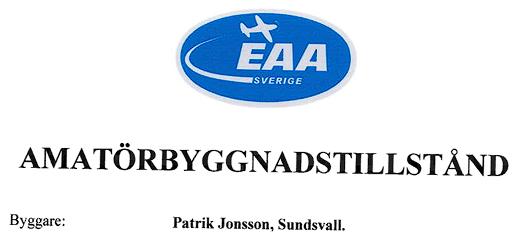Once it became clear that building was going to take place in Sweden, I had to start educating myself on the difference between homebuilding an aircraft in Sweden vs. in the U.S.
The legal requirements in the U.S are amazingly minimal. As long as at least 51% of the tasks have been completed by people doing the work for “recreation or education”, and you can prove that this is the case (for example by using a kit that the FAA has approved as having more than 51% of the work remaining, and having a build log of who performed the work) you can just build whatever you want. Once you’re done, you call a DAR (“Designated Airworthiness Representative”) who comes out and inspects the airplane and, more importantly, your documentation. and you get an airworthiness certificate.
The amazing thing about this is that the authorities basically give you the freedom to kill yourself, as long as what you’ve built more or less looks like an airplane you can do it, the important thing is that it’s not done for profit. Still, most builders get more help, and EAA has people available that can come and look at your work during the build, they have workshops available that teach various building techniques, and the vast majority of homebuilt airplanes today are built from kits where the kit manufacturer usually provides help and support if the builder has questions.
The process in most European countries is, maybe not surprisingly, quite a bit more regulated, but while some rules are EU-wide there are still large variations in the regulations between countries.
The situation in Sweden is interesting, because the Swedish authorities have delegated the administration of homebuilding to the Swedish EAA. That means you rarely have to deal with the actual authorities, but on the other hand means that your project is in the hands of people who are pretty much doing this on a volunteer basis.
The first hurdle that had to be surmounted was that before an airplane can be homebuilt in Sweden, the design must undergo a technical study to prove that it fulfills a bunch of safety criteria. Once a model has been approved, this study applies to all subsequent builds of that model but, as you might guess, I’m the first builder of a Sling TSi in Sweden. There were two issues with this study. The first is finding a person approved and willing to do it, which took a little back and forth with the EAA people. The second was that the person who was going to conduct the study had a bunch of detailed design questions they wanted the Sling factory to answer. The factory, in turn, was a little hesitant to provide “proprietary information” to some random guy in Sweden (since usually this would be done by someone working for the authorities) without an NDA. The EAA person, for their part, were unsure whether they could sign an NDA since government information in Sweden is, by default, public.
Luckily I was not ready to start actually building so this hangup didn’t affect me. The details of how this was worked out were not communicated to me (since they definitely weren’t providing their proprietary information to me) but all of a sudden I got word that the design study had been approved. They did an independent calculation to conclude that the design safety factor for the main spar at +3.8G and max gross weight indeed is 3x.
Another thing that’s quite different from the FAA rules is that you need ongoing inspections of the build, at least before every surface is riveted shut. (I believe this was the case for the FAA as well back in the 80s but has since been removed.) Luckily I found out that one of the EAA people with inspection authority, which means they are the equivalent to the FAA DARs that sign the final approval of the aircraft, lives in Sundsvall, and he agreed to be the inspector for my build. He’s one of the founders of Flygfabriken, a company that manufactures kits for an amphibious homebuilt aircraft, so it’s nice to have someone knowledgeable nearby that can put a second pair of eyes on my work.
With those hurdles worked out, I was finally awarded the Permit to Build (Byggnadstillstånd) in late February. Not that I was ready to start building then, either, but I could no longer blame paperwork.
While the build progresses, I have to file annual progress statements with the EAA. but until the plane is ready for final inspection there should be no other paperwork. However, in order to actually be allowed to do flight testing of your homebuilt, you need to be approved to act as test pilot. We’ll cross that hurdle when we get to it.
